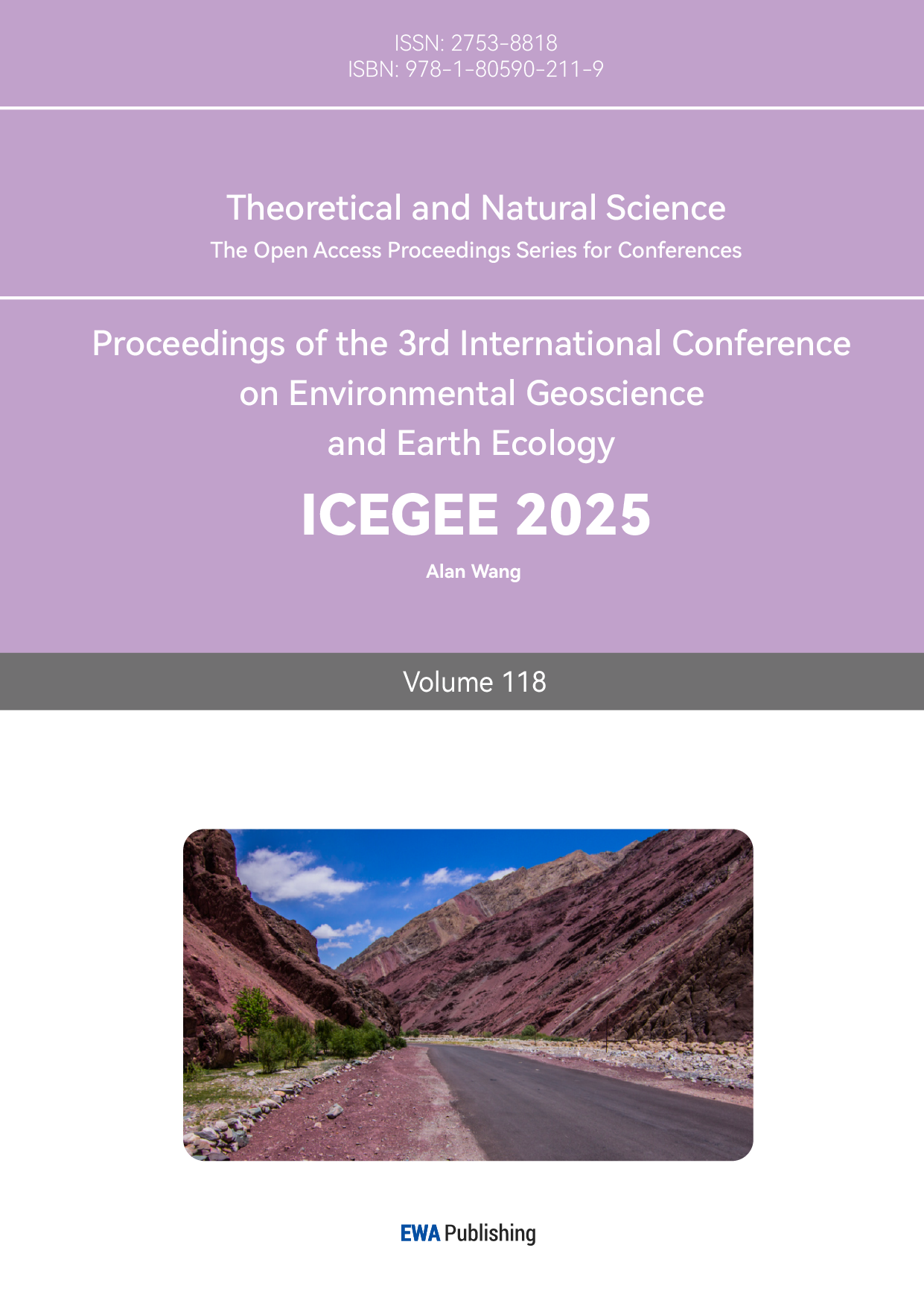1. Introduction
Hot spring tourism, which integrates wellness, relaxation, and entertainment, has long been favored by the public as a distinctive form of travel. Located in the northern part of Taiwan, the Yangmingshan area has become a popular domestic destination for hot spring tourism due to its unique and picturesque natural landscapes, abundant geothermal and hot spring resources, convenient transportation, and proximity to the large source market of the Taipei metropolitan area. Each year, it attracts a substantial number of domestic and international tourists [1].
However, with the rapid development of the hot spring leisure industry, its spatial distribution has also undergone significant changes over the past few decades. This study aims to conduct an in-depth exploration of the spatial distribution characteristics of the hot spring leisure industry in the Yangmingshan area. Through the collection and analysis of relevant literature and data, this paper seeks to provide a theoretical foundation for the sustainable development of the hot spring leisure industry in the region.
2. Literature review
Prior to this study, numerous scholars have conducted research on the hot spring leisure industry and the Yangmingshan area. These studies have approached the topic from various disciplines, including geography, tourism studies, and economics, focusing on the development and utilization of hot spring resources, changes in the hot spring tourism market, and the spatial structure and evolution of the hot spring leisure industry.
Zhao Danyang explored the development of ecotourism in Taiwan, particularly in the Yangmingshan area of Taipei, emphasizing the sustainable use and conservation of ecotourism resources [1]. Yu Guangchang and colleagues conducted a comprehensive study on the development of Taiwan's hot spring industry, analyzing the characteristics of hot spring resources and industrial development strategies [2]. Liu et al. examined the characteristics and origins of hot springs in the Tatun Volcano Group, providing valuable data and insights for understanding the hot spring resources in Yangmingshan [3]. Zhang Baotang provided a detailed description of Taiwan's hot spring resources and the current state of the hot spring industry, highlighting its impact on local economic development [4]. Wu Liangheng investigated the historical evolution of Yangmingshan and examined the development of hot spring culture and related industries in the region [5].
Building upon the theoretical foundations and methodologies established by these previous studies, this paper further refines and deepens the analysis of the spatial distribution characteristics of the hot spring leisure industry in the Yangmingshan area. The goal is to offer more precise theoretical guidance for the sustainable development of this industry in the region.
3. Research scope and methodology
Numerous studies have indicated that groundwater and surface water often originate from the same source. This study focuses on the hot spring leisure industry, which is generally influenced by local groundwater conditions. The terrain of the Yangmingshan area is characterized by a high central region surrounded by lower elevations. The main peak of Qixingshan, the highest point in the area, stands at approximately 1,120 meters and is situated at the center of Yangmingshan National Park. The boundaries of the study area include the northern coastline, the Taipei Basin, and the Keelung River valley, with an average elevation close to sea level. This topography has given rise to a spatial pattern in which rivers flow from the central Datun Mountain area toward the surrounding lowlands.
Representative rivers in the region include Huangxi, Huanggangxi, Machao Creek, and Jinbaoli Creek, each closely associated with local hot spring areas such as Shamaoshan, Xinbeitou, Yangmingshan, and Jinshan-Wanli. Accordingly, the scope of the Yangmingshan area, as defined in this study, encompasses rivers originating from the peaks of the Yangmingshan range and the townships or districts they traverse (as shown in Figure 1). The total area of the study region is approximately 484.29 square kilometers. It is also important to account for potential interference from the residual portions of the Xueshan Mountain Range located in the southern parts of Xizhi and Qidu districts during the research process.
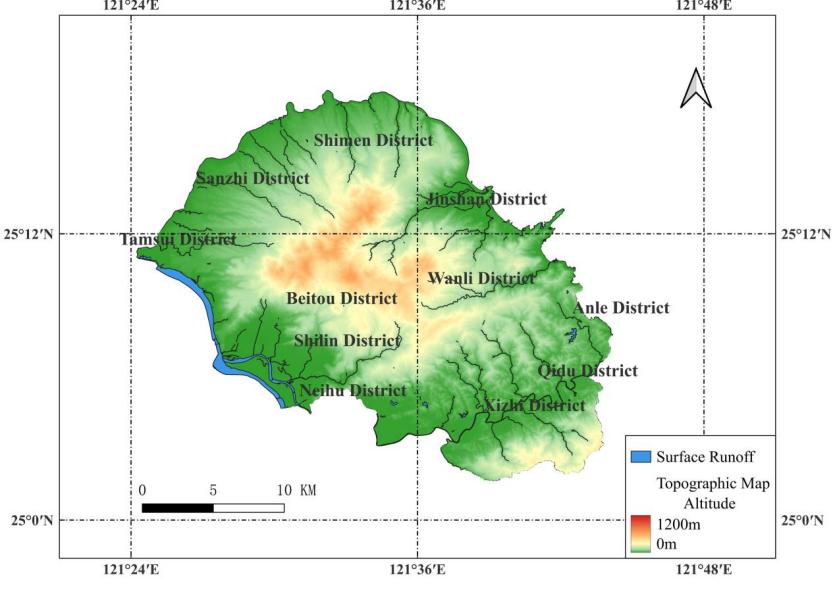
In line with the research objectives and based on methodologies adopted in prior studies, the research methods employed in this study are as follows: (1) Literature Analysis: This involves reviewing relevant literature on the spatial distribution of the hot spring industry and development cases related to the Yangmingshan area to understand the background of the local hot spring leisure industry. (2) Field Observation and Recording: On-site surveys in the Yangmingshan area are conducted to observe the actual distribution of hot spring leisure facilities and their relationships with the surrounding environment. (3) Spatial Information Processing and Visualization: Based on available data, the scale of operations and spatial distribution of the hot spring leisure industry in the Yangmingshan area are identified to analyze its spatial patterns.
4. Industry types and quantities
The leisure industry refers to commercial sectors focused on recreational activities, entertainment, sports, and tourism-related products and services. Accordingly, the hot spring leisure industry encompasses those sectors that engage in leisure activities and tourism products based on the utilization of hot spring resources. In terms of the current industrial structure in Taiwan, the hot spring leisure industry is heavily concentrated in hot spring bathing, food and beverage services, and the lodging sector [2]. Therefore, it can be broadly categorized into three main types: hot spring hotels, hot spring bathhouses, and hot spring restaurants. Field observations in this study revealed that hot spring hotels often incorporate both restaurant and bathhouse services, and hot spring restaurants generally include bathing facilities as well. Thus, in terms of service scope, the hierarchy within the hot spring leisure industry can be approximately ranked as follows: hot spring hotels > hot spring restaurants > hot spring bathhouses.
Taiwan is situated along the circum-Pacific seismic and volcanic belt, and many regions on the island have experienced or are currently experiencing volcanic activity. The geothermal resources in the Yangmingshan area of northern Taiwan are primarily sustained by deep magma from the Datun Volcano Group. From a chemical perspective, the hot spring waters in this area are predominantly chloride-sulfate springs [3]. These springs are characterized by high concentrations of sulfides and chloride ions, elevated water temperatures, and mildly acidic pH levels. Owing to these excellent physicochemical properties, the hot springs in Yangmingshan are highly suitable for medical treatment, leisure vacations, and even outdoor cooking activities—conditions that have significantly spurred the development of the hot spring leisure industry in the region [4].
This study primarily used data from the Tourism Bureau’s official lodging website as of April 2025 to collect information on hot spring hotels in the Yangmingshan area. By compiling and classifying information from the Tourism Bureau’s lodging database and the “Hot Springs of Taiwan” platform, we were able to assemble a comprehensive list of hot spring leisure industry establishments, including hotels, restaurants, and bathhouses, operating in the Yangmingshan area.
A total of 83 businesses in the hot spring leisure industry were identified. Categorically, hot spring hotels dominate the industry, accounting for 70% (58 businesses), which aligns with previous research findings. Hot spring restaurants and bathhouses are relatively fewer in number, totaling 13 and 12 businesses, respectively. This indicates that integrated hot spring hotels, which combine accommodation, dining, and bathing services, are more popular in the hot spring leisure sector, while traditional standalone bathhouses are gradually declining, particularly in urban areas.
5. Spatial distribution characteristics
After organizing the data, the spatial imbalance in the distribution of the hot spring leisure industry in the Yangmingshan area becomes clearly evident. By municipality, Taipei City has a significantly larger number of hot spring leisure establishments compared to New Taipei City, with a total of 51 businesses versus 32. In contrast, Keelung City, located at the southeastern edge of the Yangmingshan area, has virtually no presence of hot spring leisure industry and remains largely undeveloped in this regard.
When analyzed by administrative district (see Figure 2), Beitou District stands out with 45 businesses, accounting for over half of all hot spring leisure establishments in the Yangmingshan region. Jinshan District and Wanli District rank second and third, with 17 and 13 businesses, respectively. Only a small number of hot spring businesses are scattered across Shilin and Tamsui districts.
Unlike standard administrative units, a hot spring zone refers to a region where hot spring resources and related industries are highly concentrated. These zones are generally recognized by convention and do not have fixed or clearly defined boundaries. In the Yangmingshan area, four main hot spring zones are generally recognized: Xinbeitou, Shamaoshan, Yangmingshan, and Jinshan-Wanli. In some literature, “Dingbeitou Hot Springs” is mentioned as a separate zone, but since it is located upstream of the Shamaoshan Hot Springs and is less than one kilometer away, this study includes it within the Shamaoshan category. Data consolidation reveals that over 95% of hot spring leisure businesses in Yangmingshan can be classified into these four zones. Among them, the Xinbeitou Hot Spring Zone has the largest share, with 35 establishments. The Jinshan-Wanli Zone, located in the northeastern part of Yangmingshan, follows closely with 30 businesses. In contrast, the Shamaoshan and Yangmingshan zones, situated in the core area of the mountain, have comparatively fewer hot spring establishments. (See Figure 3 for detailed proportions.)
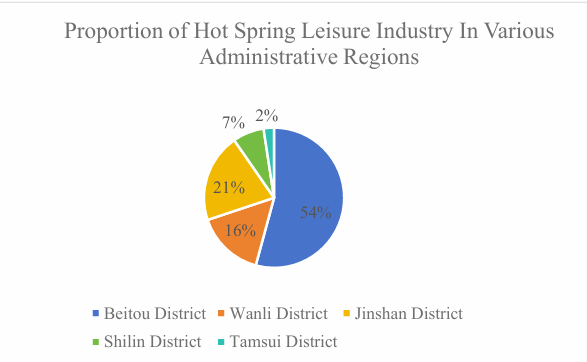
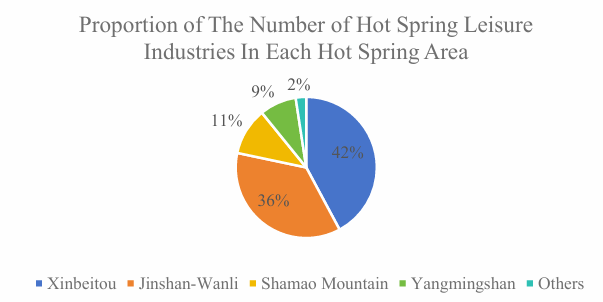
Using various data sources, the geographic coordinates of each hot spring business listed in Table 1 were determined. These coordinates were imported as scatter points into a Geographic Information System (GIS) to create a point distribution map of hot spring leisure businesses in the region. This enabled precise identification of each business’s location. Based on this, a heat map (generated through kernel density estimation) was created to visualize the concentration and clustering patterns of these businesses across the Yangmingshan area. (See Figure 4.)
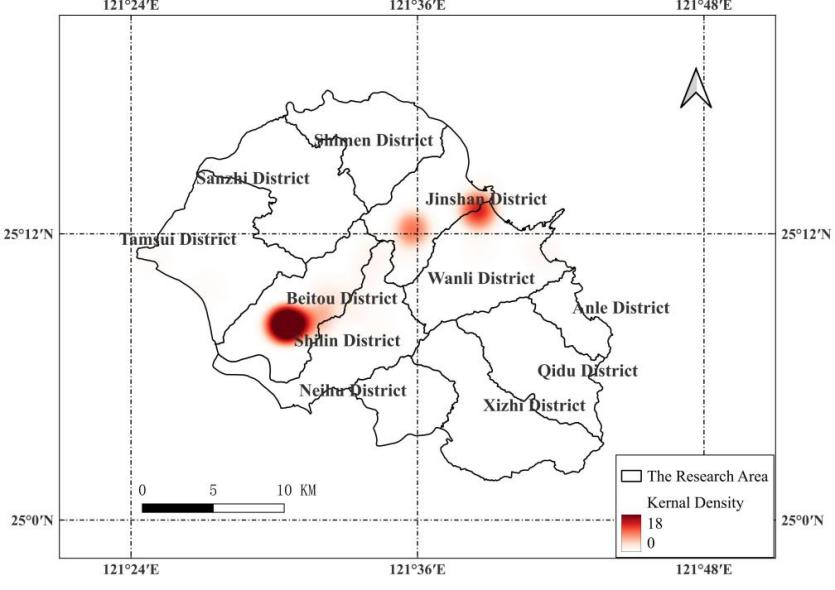
By overlaying the above point data with a Digital Elevation Model (DEM) of the Yangmingshan area, the elevation of each business location was determined. Statistical analysis shows that the average elevation of hot spring leisure establishments in the area is 115.84 meters. The lowest elevation is 2.65 meters at the Jiujinshan Governor Hot Spring, while the highest is 748.10 meters at the Lengshuikeng Public Bathhouse. Dividing the elevation data into 100-meter intervals (see Figure 5), it becomes evident that more than 60% (61.44%) of the hot spring leisure industry is located at elevations below 100 meters, mainly at the foot of the mountains, where the springs rely on downstream river water sources. The higher the elevation, and the closer the location is to Yangmingshan National Park, the fewer hot spring businesses are found. In terms of average elevation by hot spring zone: Yangmingshan Hot Spring Zone ranks highest with an average of 477.71 meters. Shamaoshan Zone follows with an average of 219.71 meters. Jinshan-Wanli Zone comes next with 92.89 meters. The Xinbeitou Zone has the lowest average elevation at only 42.26 meters.
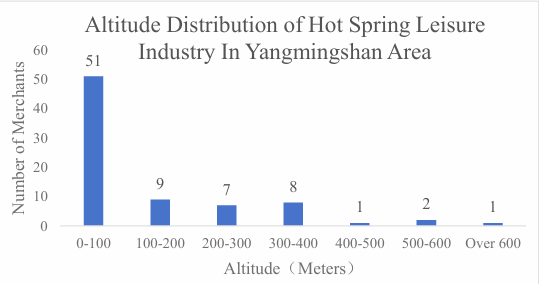
6. Conclusion
Through an in-depth analysis of the spatial distribution characteristics of the hot spring leisure industry in the Yangmingshan area, this study arrives at the following main conclusions: (1) The spatial distribution of the hot spring leisure industry in the Yangmingshan area is highly uneven. This imbalance is evident not only across different administrative districts—such as Taipei City having a significantly higher number of hot spring leisure establishments compared to New Taipei City—but also across various hot spring zones, with the Xinbeitou Hot Spring Zone holding an overwhelming advantage in terms of industry presence. This uneven distribution is closely related to multiple factors, including the region's natural geographic conditions, transportation infrastructure, market demand, and historical development patterns. (2) The hot spring leisure industry in Yangmingshan is primarily concentrated in low-altitude foothill areas, with a marked decline in industry presence as elevation increases. This trend reflects, to a certain extent, the influence of development restrictions imposed within the core zone of Yangmingshan National Park [5]. It also indicates consumer preferences and demand patterns, which favor more accessible locations for hot spring leisure activities. (3) Hot spring hotels dominate the industry structure, while the number of hot spring restaurants and bathhouses remains relatively limited. The clustering of hot spring hotels contributes to economies of scale and branding effects, which in turn enhance the competitiveness and attractiveness of Yangmingshan's hot spring leisure industry.
Overall, while the hot spring leisure industry in the Yangmingshan area exhibits distinctive characteristics across different subregions, it also shares common challenges and areas for improvement. Key issues for future development include enhancing commercial sophistication, enriching the cultural dimension of the industry, improving signage systems, and expanding entertainment facilities. These aspects can serve as critical directions for strengthening the competitiveness and sustainability of the hot spring leisure industry in various parts of Yangmingshan. At the current stage, other hot spring zones in the Yangmingshan region may look to the success of the Xinbeitou Hot Spring Zone as a reference model. However, it is also essential for each zone to develop a clear sense of identity and strategic planning tailored to its unique conditions.
References
[1]. Zhao, D. (2019). Study on the Development of Ecotourism in Taiwan – A Case Study of the Yangmingshan Area in Taipei. Journal of Inner Mongolia Normal University (Natural Science Edition), (1).
[2]. Yu, G., Zhang, L., Cai, Y., Wang, S., & Huang, J. (2008). Study on the Development of Taiwan's Hot Spring Industry. Tourism Management Academic Symposium.
[3]. Liu, C.M., Song, S.R., Chen, Y.L., & Tsao, S. (2011). Characteristics and Origins of Hot Springs in the Tatun Volcano Group in Northern Taiwan. Terrestrial, Atmospheric & Oceanic Sciences, 22(5).
[4]. Zhang, B. (2010). Taiwan’s Hot Spring Resources and Industry. Taiwan Mining, 62(4), 68–76.
[5]. Wu, L. (2022). Goodbye, Grass Mountain: The Recent Years of Yangmingshan. Taipei: China Times Publishing.
Cite this article
Ye,Y. (2025). Spatial Distribution Characteristics and Analysis of the Hot Spring Leisure Industry in the Yangmingshan Area of Taiwan. Theoretical and Natural Science,118,1-7.
Data availability
The datasets used and/or analyzed during the current study will be available from the authors upon reasonable request.
Disclaimer/Publisher's Note
The statements, opinions and data contained in all publications are solely those of the individual author(s) and contributor(s) and not of EWA Publishing and/or the editor(s). EWA Publishing and/or the editor(s) disclaim responsibility for any injury to people or property resulting from any ideas, methods, instructions or products referred to in the content.
About volume
Volume title: Proceedings of the 3rd International Conference on Environmental Geoscience and Earth Ecology
© 2024 by the author(s). Licensee EWA Publishing, Oxford, UK. This article is an open access article distributed under the terms and
conditions of the Creative Commons Attribution (CC BY) license. Authors who
publish this series agree to the following terms:
1. Authors retain copyright and grant the series right of first publication with the work simultaneously licensed under a Creative Commons
Attribution License that allows others to share the work with an acknowledgment of the work's authorship and initial publication in this
series.
2. Authors are able to enter into separate, additional contractual arrangements for the non-exclusive distribution of the series's published
version of the work (e.g., post it to an institutional repository or publish it in a book), with an acknowledgment of its initial
publication in this series.
3. Authors are permitted and encouraged to post their work online (e.g., in institutional repositories or on their website) prior to and
during the submission process, as it can lead to productive exchanges, as well as earlier and greater citation of published work (See
Open access policy for details).
References
[1]. Zhao, D. (2019). Study on the Development of Ecotourism in Taiwan – A Case Study of the Yangmingshan Area in Taipei. Journal of Inner Mongolia Normal University (Natural Science Edition), (1).
[2]. Yu, G., Zhang, L., Cai, Y., Wang, S., & Huang, J. (2008). Study on the Development of Taiwan's Hot Spring Industry. Tourism Management Academic Symposium.
[3]. Liu, C.M., Song, S.R., Chen, Y.L., & Tsao, S. (2011). Characteristics and Origins of Hot Springs in the Tatun Volcano Group in Northern Taiwan. Terrestrial, Atmospheric & Oceanic Sciences, 22(5).
[4]. Zhang, B. (2010). Taiwan’s Hot Spring Resources and Industry. Taiwan Mining, 62(4), 68–76.
[5]. Wu, L. (2022). Goodbye, Grass Mountain: The Recent Years of Yangmingshan. Taipei: China Times Publishing.





